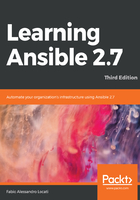
Version control systems
In this chapter, we have already encountered the expression infrastructure code to describe the Ansible code that will create and maintain your infrastructure. We use the expression infrastructure code to distinguish it from the application code, which is the code that composes your applications, websites, and so on. This distinction is needed for clarity, but in the end, both types are a bunch of text files that the software will be able to read and interpret.
For this reason, a version control system will help you a lot. Its main advantages are as follows:
- The ability to have multiple people working simultaneously on the same project.
- The ability to perform code-reviews in a simple way.
- The ability to have multiple branches for multiple environments (that is, dev, test, QA, staging, and production).
- The ability to track a change so that we know when it was introduced, and who introduced it. This makes it easier to understand why that piece of code is there, months or years later.
These advantages are provided to you by the majority of version control systems out there.
Version control systems can be divided into three major groups, based on the three different models that they can implement:
- Local data model
- Client-server model
- Distributed model
The first category, the local data model, is the oldest (circa 1972) approach and is used for very specific use cases. This model requires all users to share the same filesystem. Famous examples of it are the Revision Control System (RCS) and Source Code Control System (SCCS).
The second category, the client-server model, arrived later (circa 1990) and tried to solve the limitations of the local data model, creating a server that respected the local data model and a set of clients that dealt with the server instead of with the repository itself. This additional layer allowed multiple developers to use local files and synchronize them with a centralized server. Famous examples of this approach are Apache Subversion (SVN), and Concurrent Versions System (CVS).
The third category, the distributed model, arrived at the beginning of the twenty-first century, and tried to solve the limitations of the client-server model. In fact, in the client-server model, you could work on the code offline, but you needed to be online to commit the changes. The distributed model allows you to handle everything on your local repository (like the local data model), and to merge different repositories on different machines in an easy way. In this new model, it's possible to perform all actions as in the client-server model, with the added benefits of being able to work completely offline as well as the ability to merge changes between peers without passing by the centralized server. Examples of this model are BitKeeper (proprietary software), Git, GNU Bazaar, and Mercurial.
There are some additional advantages that will be provided by only the distributed model, such as the following:
- The possibility of making commits, browsing history, and performing any other action even if the server is not available.
- Easier management of multiple branches for different environments.
When it comes to infrastructure code, we have to consider that the infrastructure that retains and manages your infrastructure code is frequently kept in the infrastructure code itself. This is a recursive situation that can create problems. A distributed version control system will prevent this problem.
As for the simplicity of managing multiple branches, even if this is not a hard rule, often distributed version control systems have much better merge handling than the other kinds of version control systems.